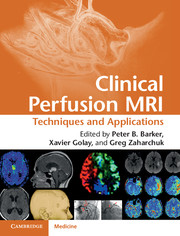Book contents
- Frontmatter
- Contents
- List of Contributors
- Foreword
- Preface
- List of Abbreviations
- Section 1 Techniques
- 1 Imaging of flow: basic principles
- 2 Dynamic susceptibility contrast MRI: acquisition and analysis techniques
- 3 Arterial spin labeling-MRI: acquisition and analysis techniques
- 4 DCE-MRI: acquisition and analysis techniques
- 5 Imaging of brain oxygenation
- 6 Vascular space occupancy (VASO) imaging of cerebral blood volume
- 7 MR perfusion imaging in neuroscience
- Section 2 Clinical applications
- Index
- References
6 - Vascular space occupancy (VASO) imaging of cerebral blood volume
from Section 1 - Techniques
Published online by Cambridge University Press: 05 May 2013
- Frontmatter
- Contents
- List of Contributors
- Foreword
- Preface
- List of Abbreviations
- Section 1 Techniques
- 1 Imaging of flow: basic principles
- 2 Dynamic susceptibility contrast MRI: acquisition and analysis techniques
- 3 Arterial spin labeling-MRI: acquisition and analysis techniques
- 4 DCE-MRI: acquisition and analysis techniques
- 5 Imaging of brain oxygenation
- 6 Vascular space occupancy (VASO) imaging of cerebral blood volume
- 7 MR perfusion imaging in neuroscience
- Section 2 Clinical applications
- Index
- References
Summary
Introduction
Apart from dynamic contrast-enhanced (DCE) and dynamic susceptibility contrast (DSC) imaging, assessment of cerebral blood volume (CBV) can also be achieved by taking advantage of differences in intrinsic MR properties between blood and surrounding tissues. In this chapter, Vascular Space Occupancy (VASO) MRI, which utilizes T1 difference between tissue and blood to separate signals from these two compartments, is described. This technique can operate in two different “modes,” one intrinsic, without the use of any exogenous contrast agent and the other following injection of a gadolinium (Gd) chelate. Since the first mode is completely based on intrinsic MR properties of the brain compartments, it can be used in subjects in whom injection of a Gd-based contrast agent might be undesirable or unsafe. For repeated measurements of CBV, the measurement can also be performed at a relatively high temporal resolution (e.g., 6 s) compared with conventional DSC or DCE methods, which require a considerable waiting time for the contrast agent to clear from the bloodstream if repetitive measurements are to be made. However, the first mode can only give relative changes in CBV but cannot be used to estimate absolute CBV. To obtain absolute CBV measurements [1], two VASO scans at pre- and post-injection of Gd-based contrast agent are needed. Compared with the other contrast agent-based methods, the VASO approach should provide higher sensitivity because it maximizes the difference in blood signal pre- and post-Gd. Also it does not require the knowledge of arterial input function, and is relatively insensitive to variations in contrast agent concentrations.
- Type
- Chapter
- Information
- Clinical Perfusion MRITechniques and Applications, pp. 89 - 102Publisher: Cambridge University PressPrint publication year: 2013



